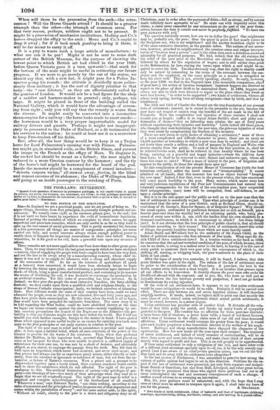THE STATUE : NOTICE TO QUIT.
Tun Queen, it is asserted, has decided that the Wellington statue shall not remain on the top of the arch at Hyde Park Corner. This story has been contradicted on presumption, and reasserted ; and so remains neither affirmed nor denied on authority. We have no means of verifying the report ; but it wears the look of probability. It is generally understood that Queen Victoria culti- vates the fine arts successfully ; and there is no doubt that, as the final decision is presumed to rest with her, the continuance of the statue where it was perched would have impugned even the young Queen's good taste. The arch, then, may have been Trenched I but now it is to be retrenched. Honour to whom honour is due Lords and Commons have not been of much use in this matter but, thank Heaven, we have, a Queen ! Until a proper tribunal be established for the regulation of these matters, the public will henceforward look to their Sovereign. When will there be the procession/eon the arch—the retro- cession ? Will the Horse Guards attend ? It should be a greater triumph than the other—the triumph of common sense. For that very reason, perhaps, soldiers ought not to be present. It might be a procession of mechanics institutions. Goding and Co.'s horses dragged the effigy to the arch : Meux and Co.'s ought to drag it away ; for if it took much goading to bring it there, it will be far mien= to carry it off. It is a pity to waste such a large article of manufacture : to what use can it be put ? Might it not be sent to some dark corner of the British Museum, for the purpose of showing the lowest point to which British art had ebbed in the year 1846, before Queen Victoria gave it a turn upwards ?—that mark for the bottom of the scale might be useful in estimating our future progress. If we were to go merely by the cut of the statue, we should say that, with a new hat, it might pass for a Police In- spector going his rounds : the attitude is decidedly more police- manly than military ; it has the sort of dignity peculiar to that body—the " raw lobsters," as they are affectionately called by the gamins of London. It would not be a bad figure for the shop of a saddler and harness-maker in general ; only, perhaps, too large. It might be placed in front of the building called the National Gallery, which it would have the advantage of screen- ing from sight ; only you will say that the remedy is worse than the disease. It might easily be converted into a locomotive steam-engine for a railway : the horse looks made to snort smoke—. the horseman would be a very proper imperturbable model for railway drivers and guards. Perhaps it might not inappropri- ately be presented to the Duke of Rutland, as a fit testimonial for his services to the nation : he could at least use it as a scarecrow to keep Free-traders off his fields.
But, after all, the best thing would be to keep it as a Trojan horse for Lord Palmerston's ensuing war with France. Palmers- ton might go, in simulated exile, as the British Sinon, and present the image to the French as the effigy of Mars. To disguise it, the cocked hat should be recast as a helmet ; the nose might be reduced to a more Grecian contour by the hammer ; and the tip of the horse's tail might be borrowed for the beard of the god. Inside the monster should be a complement of armed invaders-
ff corpora virilm," all stowed away, flirt* in the blind and inmost caverns of its abdomen ; the Duke of Wellington him- self going as an inside passenger to the retaking of Paris.



























 Previous page
Previous page